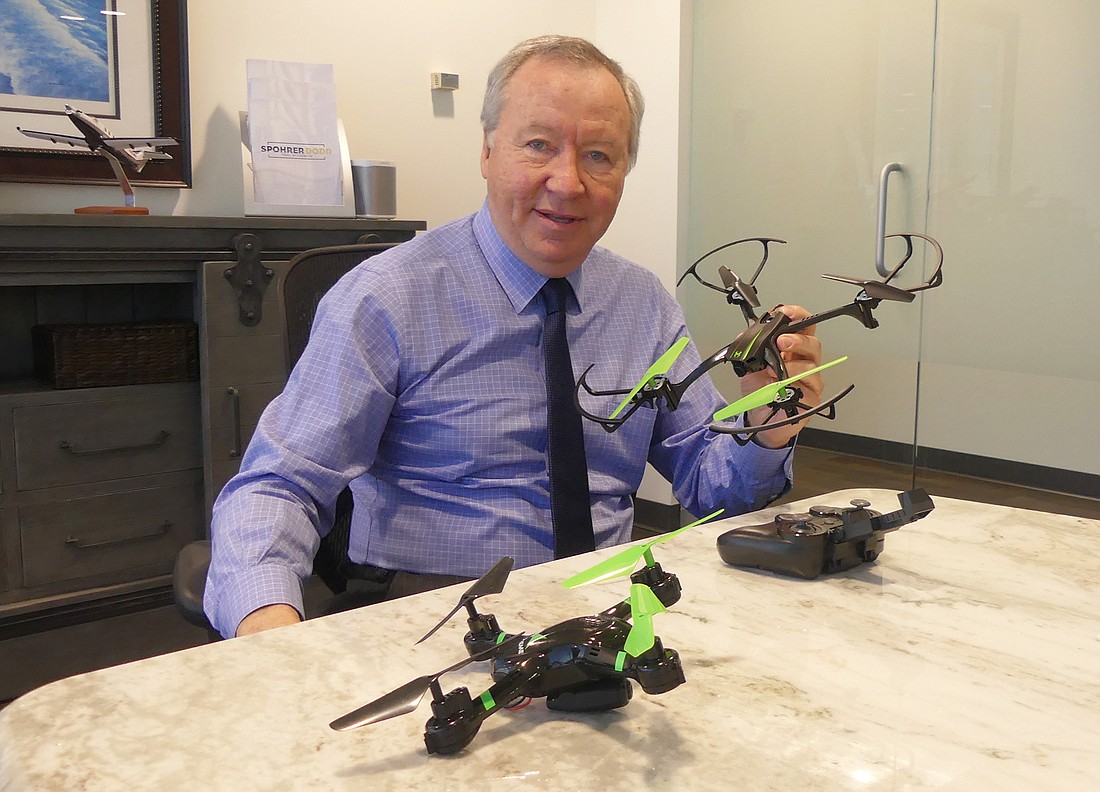
The Federal Aviation Administration calls them small unmanned aircraft systems. More than 1 million hobbyists and commercial operators call them drones.
Attorneys who practice aviation law call them the source of the most substantial change in that area of law since 1929 when the U.S. Air Commerce Act was adopted.
In January 2018, more than 1 million recreational drones were registered with the FAA. The aviation agency estimates that by the end of 2019, there will be more than 2 million registered drones.
“It’s a brave new world for the regulators, for the lawyers and for the system,” said Robert Spohrer, president of the Spohrer Dodd law firm and board-certified in aviation law.
Drones are considered aircraft under federal law. They are regulated by the FAA, which has since 2015 required drones that weigh more than 250 grams (about 9 ounces) to be registered.
Registration is easy and inexpensive by filling out an online form and paying $5 for a three-year registration for a drone that weighs up to 55 pounds.
“The FAA depends on owners to register, although there’s no teeth in the registration requirement,” Spohrer said.
With the number of small unmanned aircraft increasing, the FAA is facing challenges as the government attempts to keep up with changes in drone technology that make them easier to operate and therefore appealing to more potential buyers who will be performing more flights in more areas.
“It took the FAA several years to come up with some basic rules governing recreational and commercial drone operation. By the time they came out with the rules, a lot of the rules were obsolete because the technology had improved so much,” Spohrer said.
Safety rules published by the FAA include that drones should be flown no higher than 400 feet above the ground and must remain within the visual sight of the operator while in flight. Drones may not be flown over groups of people, over stadiums or sports events, near emergency response events such as fires or near other aircraft.
Attorney Ed Booth, a partner at Boyd & Jenerette who also is board-certified in aviation law, said there is little the FAA can do if someone fails to register a drone or fails to follow the rules.
“The FAA clearly doesn’t have the resources to enforce the regulations,” he said.
Both attorneys point out that while there hasn’t been an accident caused by misuse of a drone that led to litigation, it’s a matter of time until there is an incident, based on how easy it is to buy a drone.
Entry-level drones may be purchased for less than $100; more technically complex models can cost $1,000 or more.
“You can buy a drone at a toy store,” said Spohrer.
Using a drone as a hobby and causing property damage or injury likely could be covered by homeowners liability insurance, said Booth.
“You are responsible for what your drone does just as you are responsible for what your dog does,” he said.
A bigger issue could arise if a drone strayed or was intentionally guided into the airspace around an airport.
Spohrer said that aircraft are most vulnerable to a mishap during takeoff and landing, the period of flight when the aircraft and a drone would be most likely to share airspace based on altitude.
“Can a drone take down an airliner? No one knows, but it certainly could happen,” said Booth.
A study of how drones may interfere with commercial aviation was conducted at Embry-Riddle Aeronautical University and published in 2018 in the International Journal of Aviation, Aeronautics and Aerospace.
Researchers installed a drone detection device on a building near Daytona Beach International Airport and, over 13 days, recorded recreational drone activity in the vicinity.
Launch locations, altitudes and routes of 192 flights by 72 drones were detected.
Flights were conducted at altitudes up to 1,286 feet, more than three times the maximum allowed by FAA regulations for drones, and well into the altitude range for general aviation and commercial aircraft taking off and landing.
Of the 192 flights, 177 (93%) were conducted within FAA-designated warning or restricted areas near the airport or one of several helicopter launching and landing sites in the area.
The study found that 21.5% of the total flights exceeded the altitude limit prescribed by the FAA within warning or restricted zones and those drone flights “presented an unmitigated risk to nearby manned aviation operations.”
In addition, two flights recorded during the study “indicated uncomfortably-close operations that ultimately could have resulted in a collision,” according to the report.
In one case, the drone came within 1,000 yards of two aircraft, one of which was at the same altitude as the drone. In the other, a drone came with 500 yards of an approach path at an altitude through which the aircraft intended to land.
“I’m concerned about aviation safety in general. This is adding another dimension to the risks involved. It’s just a matter of time until there is some type of accident,” said Spohrer.
While he specializes in representing clients who have been damaged by an incident involving aircraft, Booth said he expects the enforcement of government regulations may bring him clients.
“If the FAA gets the proper funding to police the airspace, I’ll be defending people,” he said.